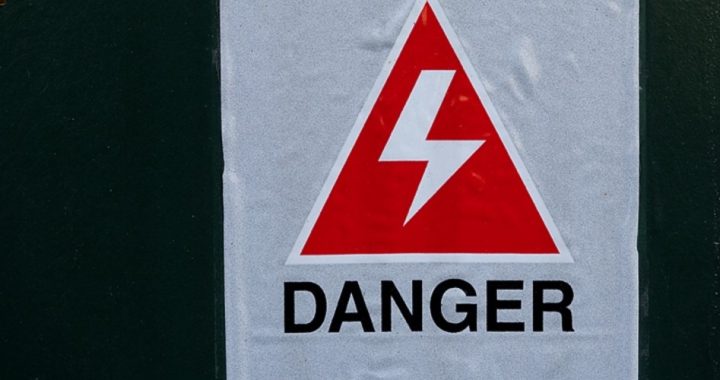
A Texas firm recently unveiled its new CUPID drone equipped with a Taser capable of delivering an 80,000-volt shock.
Austin-based Chaotic Moon Studios demonstrated its CUPID at the SXSW (South by Southwest) trade show in Austin on March 10. Billed as a “stun copter,” CUPID (Chaotic Unmanned Personal Intercept Drone) mounts its Taser on a remote controlled Tarot Hexacopter. (According to a description on the website hexacopter.us: “A hexacopter is a radio controlled flying machine similar to a helicopter but the hexacopter has six rotors mounted in an array instead of one and unlike the helicopter, it does not have a rudder.”)
Hexacopters have until now been equipped mostly with cameras designed for aerial photography. Paparazzi have been known to use drones to photograph celebrities! But Chaotic Moon Studios put a Phazzer Dragon “conductive energy weapon” (a generic “Taser,” which is a brand name of TASER International) into the drone helicopter to shoot electrified darts into its targets.
Chaotic said that CUPID could be used by law-enforcement personnel to apprehend fleeing suspects. It requires two operators, one to fly the copter and a second to fire the dart.
“The drone can be deployed when an alarm is triggered. It can find a subject and send live video to the owner’s phone and ask if you want to authorize the subject or detain them. If you detain them, it drops into fully autonomous mode to detain them until police arrive. If need be stunning them with 80,000 volts of electricity to render them incapacitated,” said a statement from Chaotic.
Chaotic co-founder, William Hurley, was quoted by Fox News of Austin: “If you imagine a S.W.A.T. raid and people running, why send officers, with guns blazing, down an alley way where they can shoot and harm an innocent person or whatever, when you could just have the drone autonomously follow them.”
Hurley told Fox News that his firm has had lots of interest in CUPID from military and law-enforcement agencies.
“This is something that’s affordable for almost everybody and in the next two or three years the technology will probably cut in half, by price,” said Hurley. “Right now, the FAA just has some vague, basic rules around them.”
However, maintains Hurley, his firm’s demonstration of CUPID at SXSW was not intended to attract business because it has “no intention of commercializing it.”
When Fox News asked Hurley why his company built CUPID, if they have no intention of producing it commercially, he replied: “I think that’s hopefully, a wake-up call. We, as a society, should all be involved in the conversation of technology governance, not just the legislators who often do a knee jerk reaction, or the inventors and entrepreneurs who often don’t think about some of the consequences of their technologies.”
If Hurley’s firm invented CUPID merely to demonstrate how it might be abused, and expect that its demonstration might lead to greater restrictions on drone use, that is an overly idealist expectation. Why does he think that the military and law-enforcement agencies have expressed interest in CUPID, if not to use it?
An article in Popular Mechanics noted that CUPID is made from many commonly available parts already used by hobbyists and that Hurley admitted that knowledgeable people could probably figure out how his team built the stun-gun-equipped copter. So although Chaotic Moon is not releasing the drone’s blueprint to the public, copycat versions could easily emerge.
Davey Alba, who wrote the Popular Mechanics report, appeared to be a little perplexed by Hurley’s inconsistent statements:
Hurley says he wants the project to raise awareness about what some hyped technologies — like drones — can actually accomplish in the real world, and to start realistic discussions about public response to technology and regulation. It certainly got people talking at SXSW, but the specifics of the discourse he wanted to spark seemed a little vague to me.
CUPID is a relatively simple device compared to some drones that our military already has produced. For example, in an article published by The New American last May, we learned that the Navy launched a prototype X-47B drone from the deck of the aircraft carrier U.S.S. George H.W. Bush. Two months later, the Navy reported that an X-47B had landed on the same ship on July 10, being “the first time a tailless, unmanned autonomous aircraft landed on a modern aircraft carrier.”
What also made the X-47B unique is the fact that it is not only unmanned, but unpiloted — it uses a pre-programmed algorithm and GPS data.
“The Navy’s model is different from the Air Force’s,” said Rear Admiral Ted Branch, the commander of Naval Air Forces Atlantic. “We don’t have someone actively flying this machine with a stick and a throttle. We fly it with a mouse and a keyboard.”
Of course, technology can be used in ways that are beneficial or harmful, the distinction often being determined by whether the party using it has secured legitimate authority. This may be a congressional declaration of war, if its use is by the military. Or it may mean getting a search warrant, if it is used for surveillance of civilians.
The absence of such authority is always problematic. When our government uses drones to strike targets within sovereign nations with which we are not engaged in a declared war, resentment and blowback against us always ensues. This has been the case in Pakistan, where Prime Minister Nawaz Sharif shortly after his election last year charged that the United States was violating the sovereignty of Pakistan by ordering deadly drone missions without the approval of Islamabad. “Drones indeed are challenging our sovereignty,” said Sharif. “I think this is a very serious issue, and our concern must be understood properly.”
Drones can also be misused in actions against Americans. This usage represents such a grave threat to our citizens’ privacy, that the Utah Senate voted 23-0 on March 4 to approve a bill restricting law enforcement’s use of unmanned aerial systems. Among other restrictions, the bill requires law enforcement to obtain a warrant before using a drone.
While it is uncertain whether it was Chaotic Moon Studios’ intention to draw attention to potential misuse of drone technology by demonstrating its CUPID system, the publicity should serve to awaken Americans to exactly how invasive such technology can become.
Related articles:
Border Patrol Loaning Predator Drones to Military, State, and Local Police
As Drone Tech Improves, Blowback From Drone-targeted Nations Worsens
Senate Subcommittee Hears Harrowing Story of Drone War in Yemen
Obama Administration Tries To Justify Proliferating Drone Strike
Drone Strike in Yemen Kills Five
Drone Operators Feeling the Effects of Carrying Out Kill Orders
State Legislatures Pass Bills Limiting Domestic Drone Use
The Thistle and the Drone: The Real Story Behind the War on Terror
U.S. Drone Strike “Mistakenly” Murders 15 Wedding Guests in Yemen
Obama Orders Drone Strikes, Killing of 6 “Suspected Militants” in Yemen
AG Holder Acknowledges Drone Killings of Four U.S. Citizen
Does Pres. Obama Commit War Crimes in Ordering Drone Strikes?
U.S. Begins Drone Strikes in Somalia
First Man Arrested By Aid of Drone Convicted in North Dakota
Obama Considers Killing American with Drone
U.S. Commits to Dial Down Drone Strikes in Pakistan
Utah Legislature Sends Drone Surveillance Nullifying Bill to Governor
Pakistan’s Sharif Asks Obama to End Drone Strikes
Domestic Drone Launch Date Approaches; Drones to Be Autonomous
Military and Police Drones Exempted From New Texas Drone Law
Pakistani PM Accuses His Own Military of Deadly Collusion With CIA



